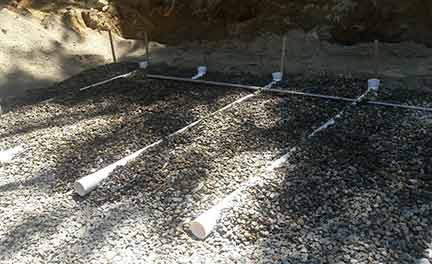
If your home has an onsite wastewater management system or septic system, it means there is a leach field attached to that septic system. Leach lines (also known as leach field, percolation bed, leach bed, or filter bed) occupy the final phase of your home’s sewage treatment system.
What are leach lines, what do they do, what can go wrong with them, and how do you know when it is time to replace your leach lines? To understand leach lines, you first need to understand how septic systems work.
How septic systems work
Septic systems or onsite wastewater management systems do the same thing as municipal waste systems. The difference is the septic system is situated in your home and serves the needs of your house, says Mike Dunfee Property Management, unlike the public waste system which serves the entire city.
The purpose of the septic system is to capture wastewater from your home and render it harmless by killing the pathogens in it. That water is then returned to the environment as clean, safe water. Here is how the septic system does this:
- Graywater from sinks, showers, and bathtubs, along with liquid and solid waste from the toilet enter the sewer pipe to be transported to an underground septic tank.
- In the first compartment of the septic tank, heavy waste materials settle to the bottom, while lighter materials like oil and grease rise to the surface to form a layer of scum.
- The liquid in the waste or effluent passes through a series of baffles and screens, designed to keep out solids and scum before it reaches the back compartment of the septic tank.
- From the back compartment, the effluent flows through an effluent filter to enter the leach lines after being partially treated.
What are leach lines?
Leach lines are a system of perforated pipes that disperse processed wastewater into the soil so that soil bacteria can complete the treatment process by converting wastewater into groundwater. These pipes are buried in the ground and distribute the effluent into as wide an area as possible.
Leach lines are usually made of PVC pipes with small holes for water to trickle through. The pipes are laid in a bed of gravel and sand; modern systems may be covered with plastic septic chambers. Effluents entering the system sit in the soil long enough to be fully treated before percolating downwards.
Leach lines are the final step in your home’s wastewater management system. If for any reason the leach field fails, the entire septic system for that home has failed.
What can cause a leach field to fail and how do you know when this happens?
Why leach lines fail
Leach lines typically have a life expectancy of 15-25 years, but a leach field that is properly maintained can last as long as 25-30 years. Conversely, a leach field may fail well before the 15-year mark if it is not cared for.
Some reasons for leach field failure include:
- Overwhelming the leach lines through excessive use of water. Leach fields are only able to handle a certain amount of water. If this limit is exceeded, the field will fail.
- Poor septic tank maintenance allows sludge and floating scum to find their way into the leach lines, thereby blocking them.
- Raising the soil level above what is specified for the proper functioning of the leach field. This leads to soil compaction and prevents evaporation.
- Planting trees and landscaping shrubs close to or on the leach field.
- Driving heavy vehicles over a leach field.
Signs that your leach lines have failed
Even though the leach lines are buried in the ground, there are ways to tell if the system has failed. The following are telltale signs that your leach field has failed or is nearing failure. The more of these signs you see, the more severe the problems with the leach field.
- Standing water in the yard: If you find wet spots on the leach field, you have reason to be worried. Puddles in a leach field mean the lines cannot handle the volume of water.
- Sewage odor: If there is a persistent smell of sewage inside and around the house, it means the system is broken. The essence of a septic system is that you should never encounter the waste from your home.
- Presence of slime: If you spot a black slimy substance on the surface of the leach field, you have a major problem. Call for septic services immediately.
- Slow drains: The drains in your home are running slower. Slow drains that persist for more than a week are an indication of problems with your septic system.
- Excessive plant growth: If you find that grass or plants on one area of the leach field are growing faster or looking greener than those on other parts of the field, it is time to have a local plumber.


